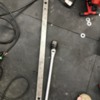And, with a “Torque Meister”, it also makes it easier to over-torque whatever you are tightening, if you’re not careful. Jus’ sayin’....
Good sockets last and last. I bought my first 36mm X 1/2” drive, a Craftsman silver - regular duty, in 1967 because my older brother moved out and took his Porsche-related tools with him. Then, I broke it that winter while removing a gland nut (that sounds a bit weird, doesn’t it?), got a new one free from Sears and, at the same time, I also bought a 36mm X 3/4” drive Impact socket. I still have both of them, regular one in my mobile tool box, the impact one in the shop chest.
On an IRS rear, I usually shoot for 275 - 290 ft. Lbs., which is my weight somewhere around 20” from the socket center which, for me, is around 280 ft. Lbs, depending on cranking it a bit tighter to make the nut line up with the cotter pin holes. Easy-Peasy and has worked fine for me.
Oh......And delete the locktite when you re-assemble. You have a nut lock in that little wire and retainer. Put that on properly and that nut ain’t going nowhere. NAPA and others carry locktite remover, if you want to get rid of the residue. Why they used locktite red (especially) in the first place is beyond me. That stuff really holds, doesn’t it? Come to think of it, if you have some acetone in the shop, try seeing if that will soften the locktite to remove it. Might not be quite as effective, but might also do the trick after a while.
And BTW, I bet that nut was NOT over-tightened when it was earlier installed. If it had Locktite RED on it then the locktite was intended to be PERMANENT and resisted being turned because it was glued in place! That is why it came off so hard AND resisted up til the last 1/2” or so (because the locktite was applied farther down the threads).













